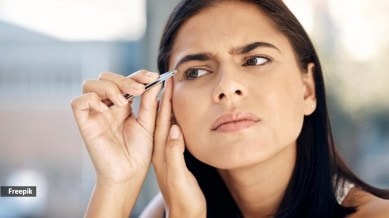📣 For more lifestyle news, click here to join our WhatsApp Channel and also follow us on Instagram
Weighing the pros and cons of different facial hair removal methods
Since the skin on your face is more delicate than the rest of your body, it's important to explore all your options before going all in with a pair of tweezers or a strip of wax. Here are some methods by which you can remove facial hair

Having facial hair as women is as normal and natural as having hair on the rest of your body, no matter what we’ve grown up believing. From the subtle peach fuzz on your cheeks to the little hair coming out of your chin, facial hair is nothing to be ashamed of, even if your parlour waali didi makes you believe otherwise.
In the pursuit of smoother skin, however, individuals often seek effective, painless, and long-lasting methods to manage facial hair. Since the skin on your face is more delicate than the rest of your body, it’s important to explore all your options before going all in with a pair of tweezers or strip of wax. To make it easier for you, we turned to experts to understand the various techniques for facial hair removal, each with its own limitations.
monthly limit of free stories.
with an Express account.
Here are some methods by which you can remove facial hair:
Waxing
Waxing has been a popular choice for facial hair removal for decades. However, Dr Seema Oberoi Lall, consultant, dermatology, CK Birla Hospital, Gurugram advises against it. “You can experience adverse effects after waxing your facial hair. The wax itself is very hot, which can lead to potential burns. When hair is forcibly pulled out, it can also lead to abrasions and injuries on the skin,” she said.
Apart from this, it can lead to the hair follicles getting infected, causing acne form eruption. “There is another possibility of your finer hair becoming thicker over time,” Dr Lall explained.
Hair removal creams
Hair removal creams, also known as depilatory creams, are chemical formulations that break down the hair structure, making it easy to wipe away.
While they are ideal for those seeking a painless solution, Dr DM Mahajan, senior consultant, dermatology, Indraprastha Apollo Hospital, New Delhi, said that it is essential to be cautious when using these creams on the face. “Some people may be sensitive to the chemicals in depilatory creams, leading to skin irritation or allergic reactions. Performing a patch test before applying the cream to the entire face is recommended.”
However, one advantage of using hair removal creams on the face is that they can provide a smoother finish compared to shaving, as the chemicals dissolve the hair just below the skin’s surface. “Additionally, the process is relatively quick, and the results can last longer than shaving since the hair is removed at the root level,” Dr Mahajan explained.
Threading
Originating from ancient Eastern cultures, threading involves the use of twisted cotton threads to trap and lift hair out from the follicle. “It is particularly effective for shaping eyebrows due to its precision,” said Dr Mahajan, adding that it gives longer-lasting results compared to methods like shaving.
Despite its efficacy, Dr Mahajan cautions that threading can potentially lead to ingrown hair. “Ingrown hair occur when the hair curls back or grows sideways into the skin, causing inflammation, redness, and sometimes infection. While threading itself does not cause ingrown hair, improper technique or unhygienic practices during threading can contribute to their development.”
Shaving
One of the most accessible and instant methods for facial hair removal, shaving offers a pain-free and quick way to achieve a smooth complexion. Dr Lall suggests using a good quality razor to prevent irritation and following it up with a proper skincare routine pre- and post-shaving.
Laser hair reduction
Laser hair removal is a more permanent solution that uses concentrated beams of light to target hair follicles. While it requires multiple sessions for optimal results, laser hair removal offers long-term results.
“This method is effective for reducing hair growth, but it may not guarantee complete hair removal. It works best for people with thick, black and dark hair on the face,” Dr Lall said.
She recommends consulting a dermatologist before going for it to check if the facial hair is due to an underlying hormonal imbalance, which needs to be treated simultaneously to achieve best results.
Bleaching
Bleaching is a method that lightens the colour of facial hair, making it less noticeable. “This technique is suitable for individuals who prefer not to remove facial hair but want to camouflage its appearance. Facial hair bleach typically contains hydrogen peroxide or other chemicals that lighten the pigment in the hair,” said Dr Mahajan.
Individuals with very fine hair on the face are the ideal candidates for bleaching. “So, if your hair is not visible from a social distance, then you can get them bleached, otherwise laser hair reduction is more suited,” Dr Lall said.
Dr Lall emphasises that the best method for facial hair removal depends on individual needs, skin sensitivity, and hair type. “Before opting for a specific technique, consulting a dermatologist is advisable, especially to rule out any underlying hormonal imbalances or medical conditions contributing to facial hair growth.”
📣 For more lifestyle news, click here to join our WhatsApp Channel and also follow us on Instagram